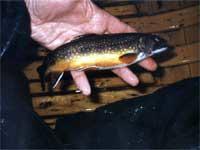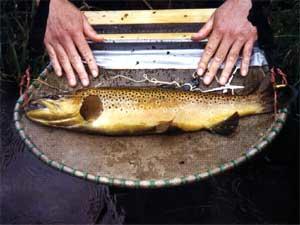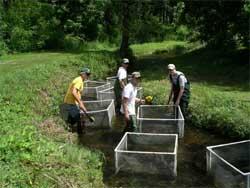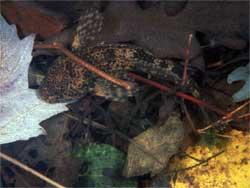Investigator: Bruce Vondracek
Student: Julie Zimmerman (Fisheries- University of Minnesota)
One of the most widely introduced sportfish is the brown trout (Salmo trutta) that was introduced from Europe and has established reproducing populations in 39 states of the continental U.S. Introductions of brown trout have often resulted in increased biodiversity in a stream because native fish fauna have not been extirpated. However, nonnative brown trout have been shown to compete with native fish species and may cause species replacement or changes in community structure or function. Although several studies have examined interactions between introduced brown trout and native brook trout, little information is available on effects of brown trout introductions on stream communities (including non-game fish and macroinvertebrates). Brown trout have been found to reduce growth of slimy sculpin (Cottus cognatus) in Valley Creek, Minnesota and may also reduce abundance of invertebrate prey (primarily Gammarus pseudolimnaeus).
The goal of this research was to examine how stream communities change in a stream where native brook trout have largely been replaced by nonnative brown trout. We designed a field experiment using enclosures/exclosures (1m2) that was replicated 6 times during 2002-2004. Specifically, we investigated the effect of interactions between brown trout, brook trout, and slimy sculpin on benthic invertebrate assemblages, fish diet composition, and fish growth. Our objectives were to: (1) assess whether small enclosure experiments conducted in natural stream systems were an appropriate method to investigate interactions between fish, or if using enclosures biased experimental results; (2) investigate whether interactions between brown trout and slimy sculpin were similar to interactions between brook trout and sculpin, by examining growth; and (3) compare indirect interactions between each trout species and sculpin, by examining effects of interspecific interactions on benthic invertebrate assemblages and prey selection of each fish species.
The 1m2 enclosures did not reduce total invertebrate drift density or drift rate. Thus, enclosures did not likely bias our experimental findings. We found that introduced brown trout have effects on the stream community in Valley Creek that are different than native brook trout. Interactions between brown trout and slimy sculpin led to reduced growth of both large slimy sculpin and large brown trout in enclosures, whereas presence of brook trout was not associated with changes to sculpin growth. Presence of brown trout also led to indirect effects on food web dynamics that may have resulted in these observed changes in growth. Brown trout was the only species associated with a decrease in abundance of a benthic invertebrate taxon, suggesting that brown trout may feed in the benthos to a greater extent than brook trout. Diets of brook trout, brown trout, and slimy sculpin had high overlap (measured by biomass), and were dominated by Gammaridae. Brown trout were also associated with shifts in sculpin diets, indicating a change in sculpin feeding behavior when sculpin were with brown trout that was not evident when sculpin were alone or with brook trout. Feeding behavior and intraspecific interactions among brown trout, along with shifts in feeding behavior of sculpin when brown trout were present, likely was a mechanism underlying reduced growth of both species.
Acknowledgments: Funding for this project was provided by a fellowship from Austen Cargill II, a doctoral dissertation fellowship by the Graduate School of the University of Minnesota, and grants from the American Fisheries Society, the Kalamazoo Valley Chapter of Trout Unlimited, the U. S. Geological Survey, Cooperative Research Units Program, and the Dayton-Wilkie Natural History Fund of the Bell Museum of Natural History. We thank Janice Odegaard, the Afton Land Limited Partnership and the Meier family for allowing us access to Valley Creek.
Publications and Dissertation:
Zimmerman, J. K. H. and B. Vondracek. 2006. Stream enclosure effects on drifting invertebrates and fish growth: do enclosure experiments produce biased results? (Accepted by the Journal of the North American Benthological Society scheduled for scheduled for volume 25, issue 2).
Zimmerman, J. K. H. 2005. Interactions between native and nonnative species: consequences of a brown trout introduction on a coldwater stream community. Ph.D. Dissertation, University of Minnesota, St. Paul, Minnesota.



